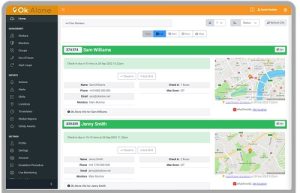As an employer duty of care extends beyond the traditional office or worksite to include remote or lone workers who operate in secluded or hazardous environments. To address this concern, a comprehensive safety solution, the lone worker monitoring system, was developed to monitor and protect lone workers. This system provides employers with real-time insights into the safety and well-being of their employees, giving them the ability to act immediately in case of an emergency.
What Lone Worker Monitoring System do you need?
There are many different lone worker monitoring systems available that work in many different ways. Some include additional lone worker devices, others a personal panic alarm. However, all of them have key features that focus on keeping workers safe during their shift, whether they are in remote locations or at home experiencing medical emergencies. But what kind of safety monitoring does a lone worker product need?
Let’s discuss how a comprehensive lone worker monitoring system should work and what it should include.
Building Blocks of a Complete Lone Worker Monitoring System
What the App should Do

The first piece is a simple to use smartphone app, for iPhone and Android, that can be downloaded by the worker (no additional equipment is required). The lone worker app should have clear, easy to use buttons that allow a worker to follow the check in procedure or request help (a panic button).
The app should have a set duration that is counting down to the workers next check in. The act of ‘checking in’ lets the person monitoring the worker’s safety know they are all right and gives their current location.
How Alerts work in a Lone Worker Monitoring System

When a worker’s check in is due an alarm goes off on their phone, this is to remind them to check in. If this is ignored a second check in alert will sound asking them to check in and confirm they are all right. This second attempt at contact is to cut down on false alarms. The app also allows a worker experiencing ill health or who has been involved in an incident that has resulted in an injury to push the help button and request immediate assistance.
If a worker misses a check in or requests help their status, current location (in real time) and their personal safety plan (an escalation procedure) are sent as an automatic notification alert to someone who can help.
How the Worker's Safety is Monitored

Within the dashboard the person monitoring the lone worker will have access to maps with real time locations and the worker’s escalation procedure. The escalation procedure will have step by step instructions to follow of who to contact and when (an alert loop), in order to ensure the worker is reached.
The final step of an internal escalation procedure could be to call the emergency services. If a company is not able to offer round the clock monitoring to its own staff, a call centre can be used instead. In this instance, if an alert was triggered, the worker’s escalation procedure would be sent directly to the call centre for them to follow.
What Data is used in a Lone Worker System?

This technology allows the app to access real time co-ordinates and precise locations for lone workers if they miss a check in or require immediate assistance in an emergency situation.
Summary of a Lone Worker Monitoring System
It is crucial to an employer’s duty of care to have an established lone worker policy. That policy should include the use of a lone worker protection system that ensures the safety of all remote workers. Employers can do this by supplying staff with a safety monitoring device that has an array of features. The easiest way to do that is by using the technology employees already possess, therefore removing the costs of additional hardware.

Important Terms used in Lone Worker Monitoring Systems
- Worker – Person working alone (remote worker)
- Monitor – Person who receives the message that a Worker is having a problem. Monitors take action based on the Escalation Procedure
- Alerts – The message sent to the Monitor or Call centre by email, SMS, WhatsApp or automated phone call saying a Worker has missed a check in or there is a worker in distress
- Escalation Procedure – Step-by-step action plan for what to do when a worker has a problem. It’s included in the Alert message sent to a Monitor or the call centre
- Check-in – The act of a Worker confirming they are safe, typically via the app

As an expert in lone worker content management, I possess an extensive knowledge base and experience in the area of lone working and safety monitoring. My expertise in this field encompasses a wide range of areas, including risk assessment, training, communication, and technology. I have a deep understanding of the unique risks associated with lone workers and have researched and written many projects and articles to educate people in how to mitigate these risks.
Throughout my time with Ok Alone, I have kept up to date with technological developments, legislative changes and regulations that have been introduced to help organizations ensure the safety of their lone workers.

